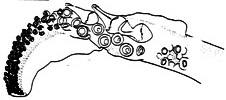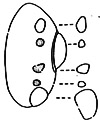Abralia andamanica
Kotaro TsuchiyaIntroduction
Abralia andamanica is broadly distributed and associated with shelf waters of the Indo-West Pacific.
Brief diagnosis:
An Abralia (Heterabralia) with ...
- very long, conical tail.
Characteristics
- Tentacle clubs
- Two or three hooks on ventral side.
- Two rows of large suckers on dorsal side of manus.
- Hectocotylus
- Left ventral arm of male hectocotylized.
- Hectocotylus with two differently sized off-set flaps.
- Eye Photophores
- Five, complex photophores: two large terminal opaque organs and three intermediate silvery organs.
- Integumental Photophores
- Ventral mantle and head with scattered arrangement of integumental organs.
- Ventral mantle and head with scattered arrangement of integumental organs.
- Mantle apex ("tail")
- Unusually long
Nomenclaure
A. andamanica robsoni Grimpe, 1931 was described as a subspecies from Japanese waters with a linear photophore arrangement on the ventral head, but is considered to be a synonym (Tsuchiya and Okutani, 1989).Distribution
Geographical distribution
This species was first described from the Andaman Sea, Indian Ocean. It is distributed widely from Sagami Bay, Central Japan through the East China Sea, and shelf waters of Southeast Asia, to the northern coast of Australia and the Indian coast.
References
Tsuchiya, K. 2000. Illustrated book of the Enoploteuthidae. In: Okutani T., ed. True face of Watasenia scintillans. Tokai University Press, Tokyo, p 196–269. (in Japanese)
Tsuchiya, K. and T. Okutani. 1988. Subgenera of Enoploteuthis, Abralia and Abraliopsis of the squid family Enoploteuthidae (Cephalopoda, Oegopsida). Bulletin of the National Science Museum, Tokyo (series A) 14: 119-136.
About This Page

Tokyo University of Fisheries, Tokyo, Japan
Page copyright © 2018
All Rights Reserved.
- Content changed 26 July 2009
Citing this page:
Tsuchiya, Kotaro. 2009. Abralia andamanica . Version 26 July 2009 (under construction). http://tolweb.org/Abralia_andamanica/19655/2009.07.26 in The Tree of Life Web Project, http://tolweb.org/












 Go to quick links
Go to quick search
Go to navigation for this section of the ToL site
Go to detailed links for the ToL site
Go to quick links
Go to quick search
Go to navigation for this section of the ToL site
Go to detailed links for the ToL site